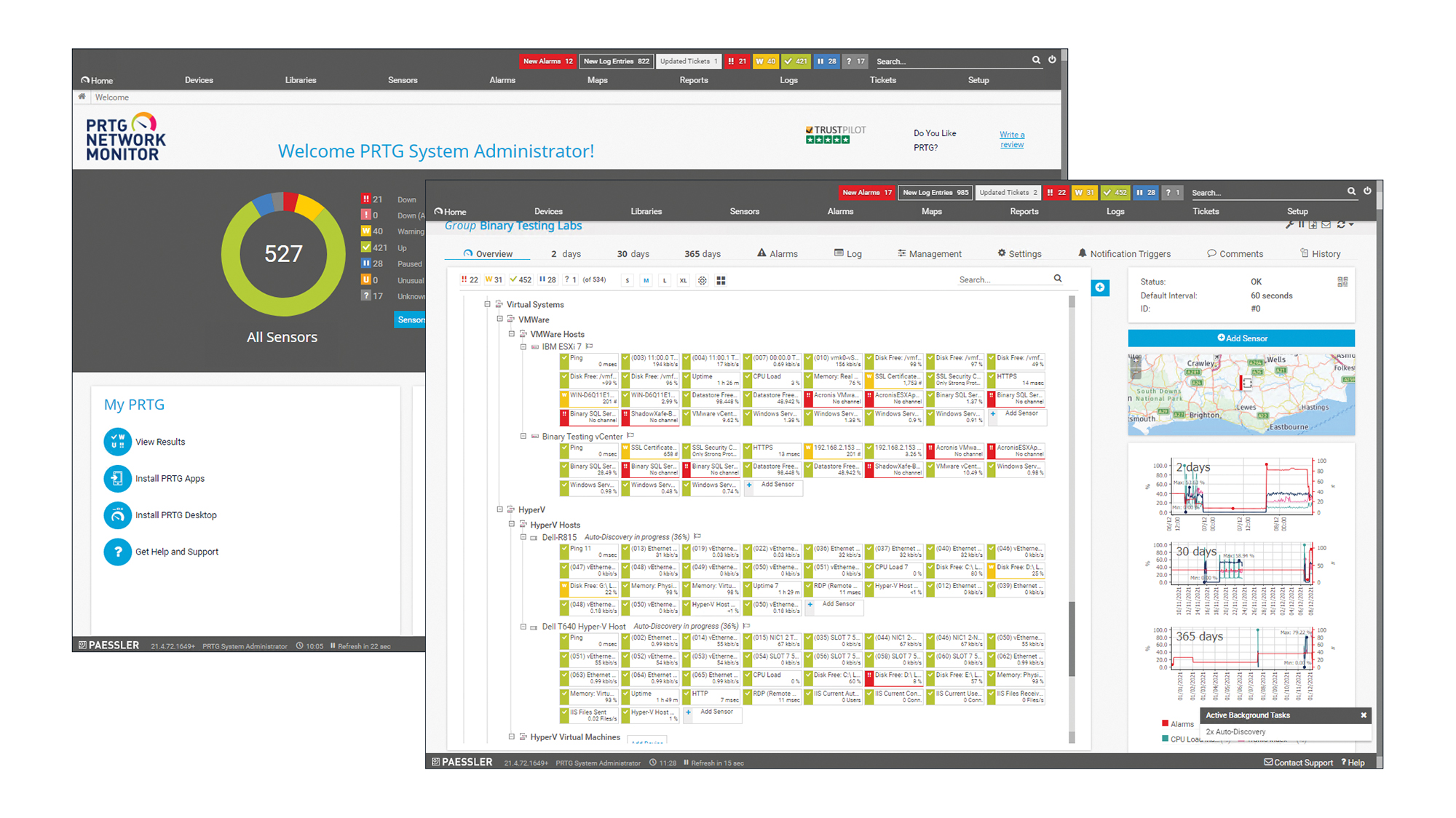Paessler PRTG Network Monitor 21.4 review: Hard to beat
This affordable and versatile monitoring solution suits all types of networks with a sensor for every occasion


-
+
Straightforward, affordable pricing
-
+
Huge range of notification options
-
+
Outstanding cloud support
-
+
Flexible monitoring
-
-
Initial discovery can be somewhat slow

If you’re feeling bamboozled by complicated licensing models, PRTG Network Monitor is the answer. Pricing is based purely on the number of sensors you want to use – and you don’t have to worry about add-ons and extras, as the entire range of 285 different sensor types is included as standard. These cover virtually every type of network device, hardware component, business app and service, so you’d be hard pushed to find something on your network that PRTG couldn’t monitor. It’s reasonably priced, too, with the Small Business package starting at €1,500 a year for 500 sensors – enough to monitor around 50 devices.
Installation is simple. After we’d loaded PRTG’s on-site server software onto a Windows Server 2019 system, a wizard guided us through our first network discovery. This took a slightly leisurely 45 minutes, but PRTG relieved us of a lot of legwork by automatically assigning a suitable set of sensors to each detected device on the network, along with preset thresholds for triggering alerts.
Once you’re set up you can access PRTG through a friendly web console. This opens with a network overview showing the status of all sensors, and clicking on any of the icons next to the donut charts takes you directly to a filtered view. Alternatively, you can open the device view, which presents a tree structure with all systems organised into hierarchical groups.
This may initially look a little overwhelming for large networks, but you can organise things by creating your own groups and moving devices into them, whereupon they inherit settings such as discovery schedules and login credentials. It’s easy to spot devices with issues as all sensor icons are colour-coded, and hovering the mouse pointer over any device pops up a window with live graphs and alert messages.

This page is also where you’ll discover how quickly the sensor count gets consumed. For example, we found that our 24-port Gigabit switch, Hyper-V and VMware hosts and five-bay Synology NAS appliance had together been allocated a total of 192 sensors. Don’t panic, though – with just a few clicks we were able to remove sensors we didn’t need and reassign them where we wanted them.
You can also add sensors for services that aren’t on the local network. PRTG supports a whole heap of cloud providers, including Dropbox, OneDrive, Microsoft 365 services and Amazon CloudWatch. Those using Azure can also set up sensors to monitor SQL databases, cloud VMs, storage and subscription costs, with more advanced sensors currently in development. All of this makes it far more flexible than the typical per-device monitoring suite.
Aside from the web console, you can keep an eye on network activity using Paessler’s desktop apps for Windows and macOS, which log in to the PRTG host and present an equally detailed summary of all sensors. Mobile access isn’t a problem either, as the free PRTG apps for Android and iOS are easily the best of their kind.
Sign up today and you will receive a free copy of our Future Focus 2025 report - the leading guidance on AI, cybersecurity and other IT challenges as per 700+ senior executives
Even when you’re not actively checking up on your network, PRTG ensures you’re kept in the loop with an extensive range of notification methods, including email, SMS, Syslog, Slack, Microsoft Teams and an MQTT service for IoT devices. Custom triggers can be applied to any level of the device tree or to individual sensors – for example, alerts can be sent when a device goes offline, when a traffic threshold has been breached or when a hard disk is getting full.
In all, when it comes to on-premises monitoring solutions, PRTG Network Monitor is very hard to beat. It provides a terrific range of sensor options for both local devices and cloud services, along with plenty of monitoring facilities, yet it’s easy to manage, and comes with a simple, affordable pricing scheme that’s perfect for SMBs.
Dave is an IT consultant and freelance journalist specialising in hands-on reviews of computer networking products covering all market sectors from small businesses to enterprises. Founder of Binary Testing Ltd – the UK’s premier independent network testing laboratory - Dave has over 45 years of experience in the IT industry.
Dave has produced many thousands of in-depth business networking product reviews from his lab which have been reproduced globally. Writing for ITPro and its sister title, PC Pro, he covers all areas of business IT infrastructure, including servers, storage, network security, data protection, cloud, infrastructure and services.
-
 CISPE claims European Commission gave Broadcom a ‘blank cheque to raise prices, lock-in, and squeeze customers’ with VMware deal
CISPE claims European Commission gave Broadcom a ‘blank cheque to raise prices, lock-in, and squeeze customers’ with VMware dealNews Cloud providers have issued a formal response to the General Court of the European Union after the Commission defended its approval of the deal
By Emma Woollacott Published
-
 Nutanix wants to help customers shore up cloud sovereignty
Nutanix wants to help customers shore up cloud sovereigntyNews New automation tools and infrastructure management capabilities look to tackle single-vendor dependency and shore up sovereignty requirements
By Ross Kelly Published
-
 The NCSC touts honeypots and ‘cyber deception’ tactics as the key to combating hackers — but they could ‘lead to a false sense of security’
The NCSC touts honeypots and ‘cyber deception’ tactics as the key to combating hackers — but they could ‘lead to a false sense of security’News Trials to test the real-world effectiveness of cyber deception solutions have produced positive results so far
By Emma Woollacott Published
